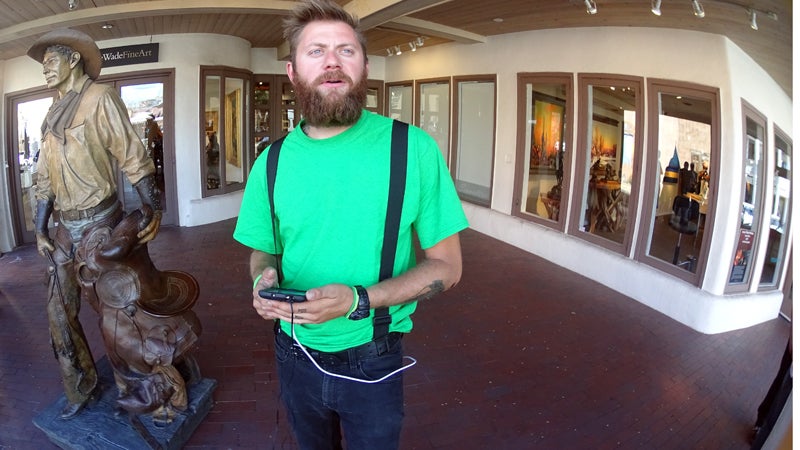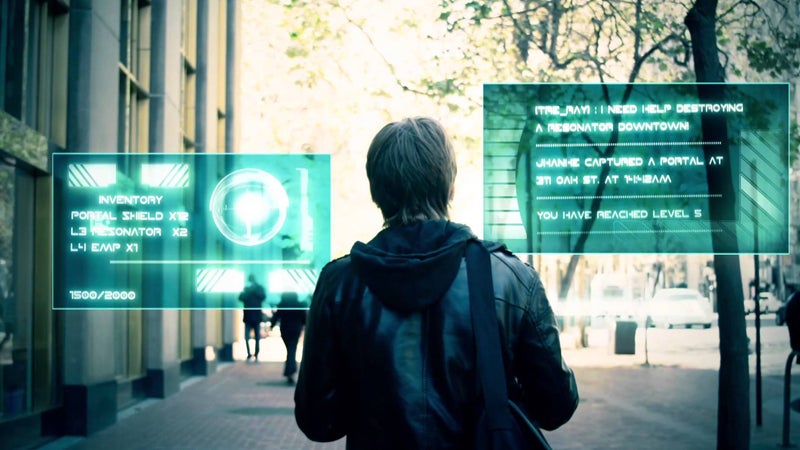Last year saw the viral success of a short film called “,” in which a young woman goes through her day, blissfully phoneless, while all of her friends canŌĆÖt put down their devices.╠²
ItŌĆÖs a familiar argument: the technology that, on the one hand, enhances our existence is simultaneously sapping the vigor from . Unless we all get brainwashed by a malevolent Silicon Valley guru, this debate will only intensify with technologyŌĆÖs continued proliferation.
No surprise then that Google, a company that has done as much as any other to ensure that so much of modern life is spent staring at a screen, would come up with a project to demonstrate that tech can be used to get us to reengage with the ŌĆ£real world.ŌĆØ
ThatŌĆÖs the idea behind a location-based gaming phenomenon called Ingress, though the projectŌĆÖs ultimate value may lie in the way it fosters camaraderie among strangers, while forcing participants to get up off their asses.
When I met him in Santa Fe prior to the start of a local Ingress tournament, William Kilday, marketing lead at GoogleŌĆÖs Niantic Labs, explained that Ingress is a kind of ŌĆ£virtual geocaching,ŌĆØ an app-based game where the playing field depicted on your screen is overlaid on actual locations all over the world. Deploying an arsenal of virtual weaponry, two ŌĆ£factionsŌĆØ(dubbed the Resistance and the Enlightened) battle for possession of ŌĆ£PortalsŌĆØŌĆöusually structural landmarks like museums or public monuments.
From a fitness perspective, the most significant aspect of Ingress gameplay is that players must be physically present at Portals theyŌĆÖre looking to claim. You cannot lay siege to the Louvre from your basement computer, unless your basement happens to be centrally located in the 1st arrondissement, in which case, lucky you.
[quote]While most Ingress participants are unlikely to scale mountains or saunter through drug cartel strongholds for game-playing purposes, one of the alleged benefits of the game is that it motivates those with sedentary lifestyles to discover a city on foot.[/quote]
╠²
Fitness can also be a factor when agents are looking to create new Portals for their faction. All potential locales must be submitted to Google for approval, and those in less accessible locations are going to be harder for the opposing side to usurp.
Thus, agents willing to go further afield are often of great benefit to their team. During the Santa Fe event, I spoke to Tim Shields (Agent name: Taaron), a computer engineer from Albuquerque and an atypically lithe member of the New Mexico Resistance faction. In the weeks leading up to the competition, he had scaled Wheeler Peak, Cabezon Peak, and Guadalupe Peak, and established a Portal in each spot.

Of course, ŌĆ£less accessibleŌĆØ doesnŌĆÖt have to imply physically arduous terrain. Hugo Marquez (Dovlek), another member of the Resistance who lives in Las Cruces, said heŌĆÖd created several Portals in JuarezŌĆöperennial front-runner for Murder Capital of the WorldŌĆöa process that involved, as he put it, ŌĆ£smuggling Portal keys over the Mexican border.ŌĆØ
While most Ingress participants are unlikely to scale mountains or saunter through drug cartel strongholds for game-playing purposes, one of the alleged benefits of the game is that it motivates those with sedentary lifestyles to discover a city on foot.
One of the sub-categories on the app is ŌĆ£Health,ŌĆØ which allows agents to see how far theyŌĆÖve walked while playing the game. As I was speaking to Kilday, we were passed by two heavyset individuals, clad in Ingress paraphernalia and making their way towards the starting location on Santa Fe Plaza. ŌĆ£See. ThatŌĆÖs a perfect example,ŌĆØ Kilday said. ŌĆ£TheyŌĆÖre going to walk for four or five miles today.ŌĆØ
But walking a city and discovering it isnŌĆÖt necessarily the same thing, especially when youŌĆÖre constantly peering at a tiny screen. I raised this point with Chris Pauli (TJinGuy), a computer and lab manager at New Mexico Tech.
He admitted that there were ŌĆ£heat-of-battleŌĆØ moments when the digital side tended to take over, but was adamant that Ingress had led him to places heŌĆÖd never have discovered on his own. He cited the ŌĆ£Shoe TotemŌĆØ Portal in Albuquerque. ŌĆ£At first, I was like, what the hell is a shoe totem?ŌĆØ he said. Now, thanks to Ingress, Chris has seen a telephone pole decked from top to bottom in high heels, like a vertical homage to Imelda Marcos.
Ingress might provide the impetus for you to discover your cityŌĆÖs inner Shoe Totem, but its tech component is so pronounced that itŌĆÖs difficult to see how that wouldnŌĆÖt dominate every other aspect of the game. Gamers must worry about things most of us try to leave behind when weŌĆÖre stepping outside for a hike or neighborhood constitutionalŌĆölike battery life and cell signal. Many players had reserve battery packs attached to their belts like live ammo. Steve Ball (sct23), an electrical engineer from Salt Lake City, had simultaneous plans with three providers, Sprint, Verizon and T-Mobile, to ensure maximum coverage. He was still looking into AT&T.
Despite this tech-heaviness, the fraternity among its geek loyalists might be an argument for why Ingress is an antidote to our . Walking around Santa Fe, embedded among Resistance agents, I couldnŌĆÖt remember the last time IŌĆÖd witnessed a group of strangers work together with such seamless (not to say wireless) sophistication.
By means of a push-to-talk app called Zello, Tim, acting as de-facto general in todayŌĆÖs operation, was in continuous contact with other clusters of Resistance agents situated throughout the city. For further tactical efficiency, Tim also kept in touch with Julie, ŌĆ£the eyes in the sky,ŌĆØ who was monitoring the gameŌĆÖs progress on a computer in a nearby apartment.
[quote]Despite the tech-heaviness, the fraternity among its geek loyalists might be an argument for why Ingress is an antidote to our╠²digital solipsism.[/quote]
This sense of fellowship also existed between warring factions. As we neared a particularly valuable Portal (referred to in the literature as a ŌĆ£VolatileŌĆØ), a number of opposing agents were lying in wait. The West Side Story showdown I was anticipating ended up being played out in the bizarre spectacle of everyone furiously hammering away on their phones for several minutes and shouting things like: ŌĆ£Deploy! Deploy!ŌĆØ ŌĆ£ItŌĆÖs ours. Put mods on it. Quick!ŌĆØ ŌĆ£Heat-sinking? You fucker!ŌĆØ
Once the virtual smoke cleared, however, there was no animosity between the two sides. People actually spoke to one another. Rivals introduced themselves using their agent names, exchanged real-world handshakes, and launched into Ingress-lingo that reminded me of how little I knew about the game I was supposed to be reporting on: ŌĆ£We thought you guys were gonna Jarvis all four of these. Keep ŌĆśem inoculated. How many resonators you got left?ŌĆØ
It was a little like IŌĆÖd picture the ambiance at a “Star Trek” convention, if “Star Trek” conventions were competitive. (Are they?) And yet, no matter which side would end up carrying the day, there was a palpable sense that everyone was in this together.


